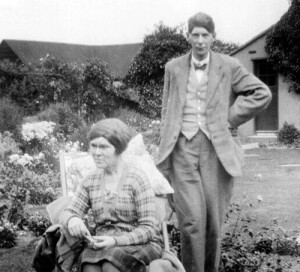 It is in The Last of Spring, one of Rupert Croft-Cooke’s many autobiographical volumes that one finds an account of the author’s experience of renting one of the Cornish bungalows built for writers by the eccentric spiritual medium and author, Mrs A.C. Dawson Scott, in the early 1930s.
It is in The Last of Spring, one of Rupert Croft-Cooke’s many autobiographical volumes that one finds an account of the author’s experience of renting one of the Cornish bungalows built for writers by the eccentric spiritual medium and author, Mrs A.C. Dawson Scott, in the early 1930s.
Croft-Cooke, armed with an advance of £20 from his publisher, Chapman Hall, following the success of his first novel was seeking a cottage in the country that would afford him the solitude and remoteness he needed to write a follow-up. He found one by answering an advert placed in a literary weekly by the novelist Dawson Scott, now better known as the founder of P.E.N. She herself lived in a holiday bungalow near Padstow and had had the idea of buying some land south of Trevose Head to build more bungalows which she would rent out to writers who needed a retreat.
The bungalows duly became a colony she called ‘ Constantine ‘, after the nearby ruins of a church and a Holy Well, aimed at providing accommodation for those attending the Cornish Art and Literature Season in July and August, when she charged £5 a week to tenants. Luckily, Dawson Scott, nicknamed ‘ Sappho’ by her family, charged Croft Cooke the off-season rate of only £1 a week. Meeting his landlady in her London flat to arrange the tenancy was a daunting experience for the novelist. He found
‘ a forceful woman, decisive and grimly affable, obviously a born organizer. I never knew her in Cornwall, yet through vivid descriptions by Noel Coward, who was one of her early paying guests, and others, I see her in fancy in her Cornish setting, square, tanned, blatantly healthy, wearing a djibba, with the wet sand oozing up between her toes, and her hair undisciplined in the breeze, a woman with a purpose. ‘
When she discovered that he intended to write a novel in Cornwall, she strongly recommended that he lease one of the bungalows
that she had named ‘ Holt’.
‘That’s the bungalow for a novel. J. D. Beresford wrote one there last summer. May Sinclair had it two years ago. G. B. Stern has written in it. Dorothy Richardson is living next door—you’ll find her down there now. Yes, Holt would be right for you. When do you want it ?’
Croft-Cooke replied ‘ next week ‘ and after being advised by Dawson Scott on train times to Padstow, local walks and shops, the character of the Cornish people and the importance of not disturbing Dorothy Richardson, he left with a strong sense of anticipation.
When he arrived at Constantine Croft Cooke found something more like a shack than a solid brick bungalow.
‘It was a cheaply built thing of timber, but it was sound and dry and without draughts. The March winds roaring across the headland made its interior like the cabin of a ship, comfortable and protected from the wild weather seen through glass. It stood, without enclosure, on the bare grassland and though the sea was not visible from its windows the gulls shrieked round it and the clouds seemed those of a seascape, rolling and sunlit white. Towards Trevose Head the downland was spattered with the bungalows of artists and writers, most of them solid and white like villas of the French coast and none of them so shack-like as mine’.
Inside the shack there was an armchair with a broken spring, some threadbare carpets but luckily ‘a fine large writing table ‘and some comfortable beds.
One his first afternoon in Cornwall Croft –Cooke was taken by Dawson Scott’s son Toby to see his neighbour Dorothy Richardson and her husband, the book illustrator Alan Odle, whose home was just ten yards away. Croft Cooke was not a fan of Richardson’s stream of consciousness writings, which he considered ‘a yawn ‘. Odle, however, was a more striking figure. According to Croft-Cooke, he was a ‘tall, mad-looking man who was reputed to be a drug-taker and looked lost and ill’. In his copy of the short-lived periodical The Gypsy (1915) Croft Cooke found five plates by Odle showing ‘ teeming figures of dwarfs and simian grotesques, skulls, leprous nudes, goat-foot gods and general mayhem ‘. To Croft Cooke, Odle’s ‘vague manner and restless eyes and hands seemed consistent enough with this sort of thing’.
If Croft-Cooke had wanted to get further acquainted with Richardson and Odle he was to be disappointed. Throughout his two month sojourn he hardly saw the couple and there were rumours that they stayed in bed to keep warm during much of their time in Cornwall. Odle had once been an alcoholic, but lack of money—for he sold very few of his drawings—may have been a factor is his later sobriety. He eventually died in the bungalow, aged sixty, in 1948, and Richardson ended up in a care home.
There still appear to be bungalows in the former ‘ Constantine’, though no doubt most have been tarted up since the early thirties. When they appear for sale some fetch eye-watering prices. It would be interesting to know if Croft- Cooke’s ‘shack‘ has survived. [R M Healey]

I am most interested in Catharine Amy Dawson Scott. I was considering visiting the Cornwall that she loved so much and loved this piece on her writers retreats. Levorna is another name that I wanted to follow up on. If you have more tidbits that reveal where these cottages stood (although she was constantly buying and selling when the need arose) I would be most grateful.